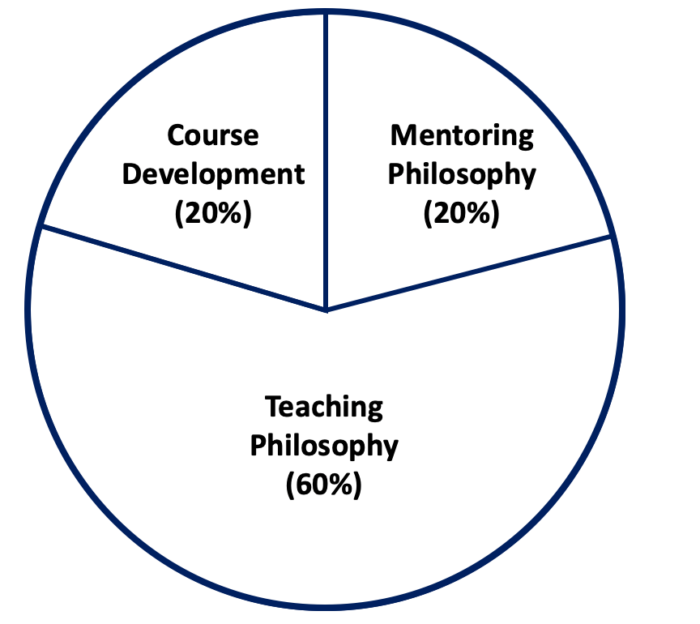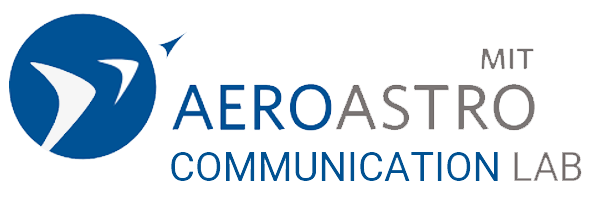1. Introduction
The purpose of this CommKit is to provide insight into components and genre conventions of teaching statements for faculty applications. After reading this document, you will (1) understand how to connect your personal philosophy on teaching and mentoring with current best practices in these areas and (2) clearly articulate how these values will be demonstrated in your classroom instruction.
2. Criteria for Success
A teaching statement serves to explain your pedagogy in depth. Pedagogy is a term that refers to the method and practice of teaching. A successful teaching statement will:
- Explain what principles guide how you approach classroom instruction and student interactions
- Explain what principles guide your mentoring philosophy
- Highlight your existing teaching experience
- Demonstrate your understanding of current teaching best practices
- Explain what existing classes you would like to teach at the university
- Explain what classes you would like to develop
3. Purpose
Your teaching statement in your faculty application package serves to illustrate your values as a teacher and how you will approach and structure your courses.
The faculty search committee uses this statement to evaluate:
- Your prior teaching experience
- Your ability to teach existing courses in the department
- Your understanding of current evidence-based teaching best practices
- Your alignment with the university’s beliefs on teaching
- Your beliefs around mentoring and how you will shape your lab environment and student interactions as a mentor
- Your ability to develop new undergraduate courses that provide students with useful skills that complement their degree
- Your ability to develop new graduate courses that will help instruct grad students doing similar research to yours
4. Structure Diagram
For faculty positions at universities with a high emphasis on research, teaching statements are usually 2-3 pages long. For faculty positions at universities with more of an emphasis on teaching (e.g. undergraduate only institutions), teaching statements can be much longer, up to 5-8 pages long. Teaching statements typically have the following content breakdown shown in the pie chart below, but you should tailor the respective ratios to the type of role you are applying to (i.e. research or teaching focused).

While there are no strict rules, we recommend this general ratio of course development, mentoring philosophy, and teaching philosophy for your teaching research statement.
There is no mandated structure for a teaching statement, but we recommend the following elements:
Teaching Philosophy (60% of statement): Highlight 2-4 key principles that inform your teaching practices. For each of your key principles, provide supplemental examples from your past teaching experiences and how you would apply them in the classroom. Ground your teaching principles in existing literature through in-text citations and references that validate the effectiveness of your approach. Detail is key, describe how exactly your proposed pedagogy would be implemented in the classroom through specific exercises and structure in the classroom. Focus on elaborating how you will adapt to students’ needs to help them be successful.
Mentoring Philosophy (20% of statement): Describe your mentoring style and explain how you will mentor your graduate students in your lab. Typically, it is common to elaborate on how often you plan to meet with graduate students, and how you envision the advisor-advisee relationship. There are opportunities to connect your philosophy from the classroom to your mentoring philosophy, but it depends on your specific values and the nature of both.
Course Development (20% of statement): Describe specific courses you would like to teach (including course numbers), both at the undergraduate and graduate level. Propose a specific new course you would like to develop at that university, what it would teach, and why it would be useful for students to take the course.
Depending on the teaching statement, certain statements ask how you will address inclusivity in the classroom or in the broader field. For those prompts, you should focus on ways to structure your courses and make your classroom inclusive to different learning styles and student backgrounds.
5. Analyze Your Audience
Your teaching statement will change depending on the school you are applying to. If you are applying to an R1 (e.g. high research output institute) your teaching statement will need to be more succinct. Depending on the school, more depth could be expected in areas like your mentoring philosophy, and your commitment to advancing diversity in the field more broadly.
Regardless of school, you should try to gain practical teaching experience before you apply on the job market. Then, you should tailor the statement to the faculty expectations of the role at the school you are applying to. For example, at an R1, you may need to address mentoring and your lab’s culture in your teaching statement as well. Conversely, at an undergraduate only, teaching focused school, your teaching statement will need to be much longer, and contain more detailed explanations of your intended classroom set-up .
6. Best Practices
6.1. Get teaching experience
The easiest way to prepare for writing a teaching statement is to actually go out and get teaching experience. Teaching experience can come from numerous avenues: formally serving as a teaching assistant or a course instructor, taking courses on teaching best practices, designing short-courses or workshops, and doing teaching outreach at K-12 schools. At MIT, there are numerous opportunities to build teaching experience including:
- Completing the MIT Kaufman Teaching Certificate
- Joining as a Fellow in the MIT Communication Lab
- Designing and teaching a course over IAP
- Being a teaching assistant for an existing course at MIT
- Serving as an instructor for a summer program targeted at high schoolers, like MITES
- Teaching middle/high schoolers through MIT Educational Studies program
- Sharing your research or participating in an outreach event at the MIT Museum
- Designing and implementing lab outreach programs for schools or the community
6.2. Reflect on what characteristics best summarize your teaching practices
For many people, a teaching statement is the first time they have been asked to articulate their beliefs on teaching. It can be hard to quickly summarize everything you believe is important in the classroom and in course design. Although difficult, this self-reflection is also the most important piece to writing an effective research statement. Below we have listed some questions that can help you figure out elements of your teaching philosophy:
- What teachers have had the biggest impact on you, and what parts of their teaching did you appreciate?
- What do you think the role of an educator is?
- Will there be projects, presentations, or papers in your classes, and what skills should they be getting from these tasks?
- How much talking do you envision yourself doing in a typical lecture? What does the structure of your typical class look like?
- What skills do you want students to have after taking your classes?
- What skills do you believe are essential for students more broadly?
- How will you help students to feel comfortable in the classroom?
- What resources will you offer to students who are struggling in class?
You do not need to answer all of these questions in your teaching statement, but hopefully these questions help you gain a better understanding of your beliefs as a teacher. You should aim to identify 2-4 principles that define your teaching pedagogy.
6.3. Use proper terminology to describe your philosophy
Now that you have identified your teaching principles, the next step is to connect these beliefs with existing teaching best-practices. Education as a field has studied teaching for centuries now, and there is a significant body of research done on the most effective ways to teach students in the classroom. It is highly likely the principle you care about already has a formalized definition in education. Some top engineering education journals are ASEE, IEEE Frontiers in Education, and the International Journal of Engineering Education. By using the appropriate terms, you help readers of your teaching statement to correctly identify the techniques you will employ.
|
Vague Example |
I pace my course appropriately so all students can keep up. |
|
Detailed Replacement |
I use scaffolding in my lectures to gradually introduce students to new topics in manageable chunks. |
Connecting your principles with education research also signals to other experienced educators that you care about teaching and are informed about teaching best practices. Using official terminology also serves to better characterize the type of techniques you will apply in the classroom with the broader body of scholarship.
6.4. Use citations to support the impact of your teaching techniques
Citations are not just for your faculty research statement, they can be used in your teaching statement as well! Do your research into education best practices and how students are impacted by various classroom environments and teaching techniques. You should approach the teaching statement with the idea that you want to pitch the value of your teaching philosophy to the faculty search committee. When appropriate, you should find and cite papers that explain the impact of applying different teaching practices. Alternatively, you can also cite papers that demonstrate the cost of neglecting to apply a certain practice. These in-text citations better support the value of your classroom design, and reiterate to readers that you are educated about teaching as a field.
6.5. Integrate examples into your teaching philosophy
Once you have identified your teaching principles and discovered the appropriate terminology to describe those principles, it is good to provide examples of how this philosophy will manifest in the classroom. Your goal is to help the reader understand how a classroom lesson from you will work, and how you will meet the diverse needs of today’s students. Ideally, you would have practiced your teaching philosophy in some capacity, and you can give examples of your in-class instruction, but this is not a requirement. It is acceptable to speak in hypotheticals (e.g. I plan to, I will) when explaining your intended classroom.
6.6. Specifically list courses that you would teach at the school
Review the courses for the department you are applying to, and list several courses that you would like to teach (both the number and the course name). Explain to the reader why you are interested in teaching those courses, and the type of courses you are excited to teach that currently exist at the school.
6.7. Describe a course that you would develop in detail
As a complement to the classes at the school that already exist, you should also describe one course you would like to develop at the university, and why. You should name the course, and describe what the course will focus on. Explain how this course will complement existing courses in the department, what skills it will provide students, and why these skills are important for them to develop.
6.8. Avoid writing flowery but meaningless sentences
In teaching statements, there is a tendency to write sentences that sound good but do not provide any insight about your teaching. As you write your statement, reflect on each sentence and assess if that statement could be said about anyone’s teaching, or something you specifically believe. This will lead to a stronger statement overall that provides more insight to your pedagogy. An example sentence is shown below
|
Vague Example |
Students in my courses will become critical thinkers, and my pedagogy seeks to draw out this talent in each student. |
| Detailed Replacement |
In my courses, I focus on extended problem-sets that allow students to independently and critically evaluate problems, forming the problem-solving skills they will need to be successful engineers. |
Remember that you are always welcome to make an appointment with an AeroAstro Communication Fellow to obtain additional feedback on your statements.
